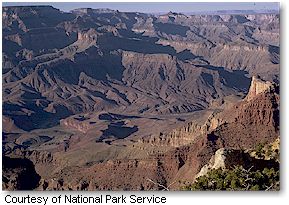|
 The Grand Canyon is more than a great chasm carved over millennia through the rocks of the Colorado Plateau. It is more than an awe-inspiring view. It is more than a pleasuring ground for those who explore the roads, hike the trails, or float the currents of the turbulent Colorado River.
The Grand Canyon is more than a great chasm carved over millennia through the rocks of the Colorado Plateau. It is more than an awe-inspiring view. It is more than a pleasuring ground for those who explore the roads, hike the trails, or float the currents of the turbulent Colorado River.
This canyon is a gift that transcends what we experience. Its beauty and size humble us. Its timelessness provokes a comparison to our short existence. In its vast spaces we may find solace from our hectic lives. The Grand Canyon we visit today is a gift from past generations.
Grand Canyon is heavily visited for most of the year and it is imperative to plan ahead for lodging, camping, backcountry permits, or mule trips. Persons planning day visits only should arrive early in the day as
parking is
limited.
Gazing at the beautiful views of the canyon from the various vista points is the number one activity for many people. People of every age and condition can find activities to suit their desires, including the following:
hiking,
rafting
trips, backpacking, mule rides or horseback rides,
camping, and
scenic air tours. A wide variety of free interpretive programs (South Rim, North Rim) are offered by NPS rangers.
Bicycling is allowed on park roads.
When visiting the South Rim, park your vehicle and ride the
Village shuttle bus to Canyon View Information Plaza, then plan your visit. At Canyon View Information Plaza you will find informative exhibits about Grand Canyon and an inspiring view of the canyon is only a short stroll away.
Facilities
Food/Supplies
South Rim: Groceries, supplies, a bank, and a post office are located at Market Plaza in Grand Canyon Village. The Village Route shuttle bus stops at Market Plaza.
North Rim: There is a small camper store adjacent to the North Rim Campground.
Museums
Kolb Studio, South Rim - Once the home and business of the Kolb brothers, pioneering photographers at Grand Canyon, this building has been restored. The bookstore and auditorium are open to the public. Art exhibits are on display in the auditorium. Located in the Village Historic District, at the Bright Angel trailhead.
Tusayan Museum, South Rim - A visit to Tusayan Ruin and Museum will provide a glimpse of Pueblo Indian Life at Grand Canyon some 800 years ago. A self-guiding trail leads through the adjacent 800-year-old ruin. Ranger-led ruin tours are offered daily. The museum is located 3 miles west of Desert View and 22 miles west of the Grand Canyon Village on Desert View Drive.
Yavapai Observation Station, South Rim - Contains temporary exhibits about the fossil record at Grand Canyon. A panorama of the canyon is visible through the building's large windows. Located 5 miles north of the park's south entrance.
Visitor Centers
Canyon View Information Plaza, South Rim - Several outdoor exhibits provide a variety of information about Grand Canyon National Park and what to do once at the park. Restrooms, pay phones, bookstore, and shuttle bus stops. The canyon rim is only a short stroll away. Canyon View Information Plaza is located at Mather Point. Access is via shuttle bus to Canyon View Information Plaza. Ride the Village Route bus.
Desert View Information Center, South Rim - Orientation, park information, and books are available. Located at the park's east entrance on the South Rim.
North Rim Visitor Center - Interpretive programs offered seasonally. The North Rim Visitor Center is open from mid-May to mid-October only. The North Rim Visitor Center is adjacent to the parking lot on Bright Angel Peninsula.
Fees:
Vehicle - $25 - 7 days
By foot, bicycle, motorcycle - $12 - 7 days
Grand Canyon Annual Pass - $50
Getting There:
Grand Canyon Village (South Rim) is located 60 miles north of Interstate 40 at Williams via highway 64, and 80 miles northwest of Flagstaff via highway 180.
The North Rim is 215 miles (about 4 1/2 hours) from the South Rim by car.
The North Rim is 44 miles south of Jacob Lake, AZ, via highway 67.
|



